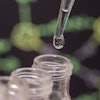Researchers at the University of Pittsburgh School of Dental Medicine are piecing together the process of tooth enamel biomineralization, which could lead to novel nanoscale approaches to developing biomaterials (Proceedings of the National Academy of Sciences, August 8, 2011).
Dental enamel is the most mineralized tissue in the body and combines high hardness with resilience, explained Elia Beniash, PhD, an associate professor of oral biology at the University of Pittsburgh School of Dental Medicine. Those properties are the result of its unique structure, which resembles a complex ceramic microfabric.
"Enamel starts out as an organic gel that has tiny mineral crystals suspended in it," said Beniash. "In our project, we recreated the early steps of enamel formation so that we could better understand the role of a key regulatory protein called amelogenin in this process."
Beniash and his team found that amelogenin molecules self-assemble in stepwise fashion via small oligomeric building blocks into higher order structures. Just like connecting a series of dots, amelogenin assemblies stabilize tiny particles of calcium phosphate, which is the main mineral phase in enamel and bone, and organize them into parallel arrays. Once arranged, the nanoparticles fuse and crystallize to build the highly mineralized enamel structure.
"The relationship isn't clear to us yet, but it seems that amelogenin's ability to self-assemble is critical to its role in guiding the dots, called prenucleation clusters, into this complex, highly organized structure," Beniash said. "This gives us insight into ways that we might use biologic molecules to help us build nanoscale minerals into novel materials, which is important for restorative dentistry and many other technologies."



















